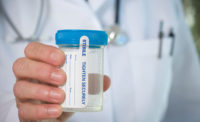- Employees who tested positive for drugs were 60 percent more likely to be responsible for plant incidents, use a third more sick leave and have more unexcused absences, according to Occupational Health Management.
- An employee who abuses drugs while operating heavy equipment might possibly damage the equipment and injure himself and/or others.
Most large manufacturing companies have some form of drug testing in place to reduce these risks and costs, according to the American Management Association. With drug abusers now less likely to apply for jobs at large companies, more medium- and small-size companies are deciding how to institute drug-free workplace programs.
The typical method is to use lab services. But lab testing is expensive and can require up to three days for results, which can create additional expense and risk. Another option is onsite testing, such as the Accutest(R) one-step rapid onsite drug tests, which delivers faster results and is less expensive.
Technically, there is little difference between onsite drug testing and lab testing. Typically, a lab utilizes an immunological-assay for initial screening of urine samples, which is similar to most rapid drug test technology. If the test results are negative, the employee can be released and return to work; if they are positive then gas chromatography and mass spectrometry (GC/MS) confirmation at a lab is required. Onsite testing follows the same procedures.
Here are the four basic types of drug-testing programs:
Pre-employment testing
Maintaining a drug-free workplace starts with screening out applicants with a drug abuse problem. Utilizing onsite drug testing reduces logistics and scheduling conflicts associated with getting a job applicant to the lab, and it eliminates no-shows at the lab. Because results are immediate, the risk of applicants accepting an offer from another competitor are reduced. Onsite drug testing also works well for temporary personnel or daily workers because results are available in minutes.
For-cause/incident testing
For-cause testing is conducted when trained supervisors determine that an employee's behavior matches the behavioral profile of one who abuses drugs. Usually, a supervisor must accompany an employee sent to the lab for drug testing, but onsite testing reduces the expense of travel time and interrupted work flow.
When testing follows an incident, all affected employees and a supervisor must travel to the lab. All those involved in the incident are typically kept on paid leave as dictated by the company's drug-free workplace policy until the test results are available from the lab, which can be as long as three days. Onsite testing enables employees with negative test results to be cleared immediately and return to work.
Only employees with tests presumed to be positive are kept on paid leave pending GC/MA confirmation.
Random testing
Random testing acts as a deterrent and, depending on the company's policy, allows the employee to be referred to counseling or a drug treatment program. Since employees are selected at random, onsite testing eliminates the disruption of work flow caused by sending employees and a supervisor to a lab.
Work re-entry
A work re-entry program monitors employees who previously have tested positive for drug abuse, participated in a rehabilitation program, and re-entered the workplace on probation. Onsite drug testing enables the employer to take action immediately. If the employee's test results are presumed to be positive, the employee can be placed on leave until the results are confirmed.
Sam Elkin, Pharm.D., is president of Jant Pharmacal Corporation, Encino, Calif., a leading supplier of diagnostic tests that include onsite drug tests. Elkin practiced as a clinical pharmacist in critical care, hospital and managed care. He is a member of the Drug, Alcohol Drug Testing Industry Association and the Health & Safety Committee of the Society for Human Resources Management, as well as a graduate of the University of California at San Francisco (UCSF).
Sidebar -
Drug testing keys
- Have a consistent policy and program
- Follow correct procedures
- Use lab confirmation for positive results
- Seek professional advice to ensure legal compliance
